Olympus E-410
-
-
Written by Gordon Laing
Olympus E-410 design
By sharing the same body as its predecessor, the Olympus E-410 also shares the joint honour of being the world’s smallest and lightest DSLR. Certainly by measuring 130x91x53mm and weighing just 421g with battery, it’s surprisingly compact. Seeing a photo of the E-410 by itself just doesn’t do it justice, so we’ve pictured it below alongside the Canon EOS 400D / Rebel XTi, a DSLR famous for being small, but which actually looks quite hefty next to the E-410.
It’s also clear from the photos Olympus has been inspired by classic 35mm film SLRs of the 80s, designing the E-410’s body with a retro style that’s bereft of the large grips you find on modern DSLRs – indeed there’s little grip to mention beyond a slightly raised surface on the right hand side. This is particularly apparent in the photo below
As we wrote in our E-400 review, the combination of reduced dimensions and lack of apparent grip would normally sound alarm bells in terms of comfort and usability, but there’s thankfully little cause for concern here. While there’s obviously less to wrap your fingers around, the E-410 can still be held comfortably and securely, and after only a few minutes you forget the absence of a modern grip. This shouldn’t come as too much of a surprise though, as this was the way all 35mm film SLRs were made for years with little or no complaint.
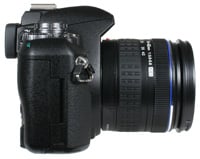 |
The lack of a modern grip has also allowed the E-410 to avoid common criticisms levelled at the Canon 400D / XTi and other tiny DSLRs. After all, since there’s no grip, there’s no tight area between it and the lens barrel to pinch your fingers.
The funny thing about the E-410, like its predecessor, is just how quickly you become used to this design. Carefully placed rubber surfaces allow you to hold the body quite securely – and comfortably – and at few times do you miss the grip of modern DSLRs, although if you intend to use the E-410 with big lenses we’d advise trying the combination in person before buying. While light, the E-410’s operating weight also feels well-balanced for the body size. The only ergonomic downside, inherited from its predecessor, is the position of the right strap eyelet which can dig into your right hand a little.
The E-410’s weight and price-point unsurprisingly result in a plastic shell, but its glass-reinforced construction feels solid and very well-built without any creaks or poor joins. In these respects it feels built to a similar standard to Canon’s 400D / XTi, although the slightly textured finish gives the E-410 a less plasticky, and more serious look.
Finally, by sharing the same body as its predecessor, the new E-410 can use the existing PT-E03 underwater housing which is good to depths up to 40m – and the Live View facility should be very helpful for composing in this environment. This is an advantage it has over the forthcoming E-510 for which there’s currently no underwater housing option.
Olympus E-410 controls
The control layout is identical to the earlier E-400 and similar to other previous Olympus DSLRs. The upper right surface is home to the main command dial which offers Auto, Program, Manual, Aperture and Shutter Priority modes, along with direct access to five popular scene presets and a dedicated Scene position which provides access to the full selection of 20 via an on-screen menu, complete with example images and a brief description. An interesting new preset for the E-410 is panorama, which exploits the Live View feature to assist in stitching multiple images like many compacts.
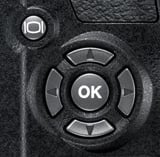 |
To the right of the main command dial is a single thumb dial, used to adjust the aperture, shutter speed, playback magnification or various menu options, while towards the front of the camera lie the shutter release and exposure compensation buttons. The upper left side is home to just two buttons controlling the drive mode and flash options.
Round the back there’s four buttons to the left side of the screen for image playback, image delete, accessing the main menu and switching the on-screen information. To the right of the screen are a traditional four button layout with an OK button in the middle for navigating and confirming options, along with an AEL / AFL button by the viewfinder and another which activates the Live View feature.
This last button is the only control difference between the E-410 and its predecessor, replacing the E-400’s Fn button. The E-410 now uses its left arrow button as a programmable function key, and can be set in the Menu to offer one-touch white balance, shoot a test photo without saving, or the choice of depth-of-field previews using the optical viewfinder or the Live View facility.
Interestingly, while there’s essentially the same number of buttons on the back as rival DSLRs, none are labelled as offering direct access to popular settings such as the ISO, White Balance, Metering or AF modes. At first this seems like a terrible omission, but like its predecessor and the E-500, the new E-410 employs a surprisingly quick and easy means to adjust a huge variety of options which we’ll fully describe in our Features section and demonstrate in our video tour. Far from a compromise it’s a system which works very well in practice.
Olympus E-410 metering and exposures
The Olympus E-410 offers five metering modes: 49-zone Digital ESP, Center-weighted, and the choice of three spot-metering options. Along with normal spot-metering, the additional Hi Spot and SH (Shadow) Spot modes are designed for scenes dominated by large areas of light and dark respectively; these modes then deliberately over and under-expose respectively to compensate.
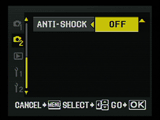 |
The E-410 offers shutter speeds from 1/4000 to 60 seconds plus a Bulb option up to eight minutes. Unlike its predecessor, the E-410 now allows you to capture the full eight minutes at any sensitivity, whereas the E-400 reduced the maximum exposure time at higher sensitivities – for example at 1600 ISO you were limited to exposures of just two minutes. While eight minutes is still limited for anyone into serious astrophotography, at least the sensitivity restriction has been lifted on the E-410- and an Anti-Shock menu option also allows you to set a delay between the mirror flipping and the shutter opening.
Exposure compensation is also available in a wide range of +/-5EV and indicated numerically through the viewfinder and on-screen. For sensitivity and continuous shooting details, see the Sensor page in our Features section.
Olympus E-410 flash
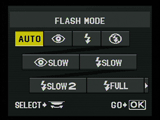 |
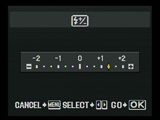 |
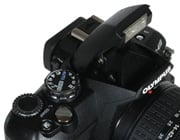 |
Pressing the flash button once pops up the built-in flash and pressing it again presents a wide variety of options including Auto, redeye, always on, forced off, slow sync with or without redeye, slow sync with rear curtain, and four different power options. The main menu additionally offers flash compensation settings and you can also set an option which prevents the flash from popping-up automatically if preferred.
The E-410 is additionally equipped with a hotshoe which offers TTL Auto options with the optional FL-50, FL-36, FL-20, RF-11 and TF-22 lights, although it doesn’t support the FL-40 and there’s also no PC-sync port. The maximum flash sync is 1/180.
Olympus E-410 battery and connectivity
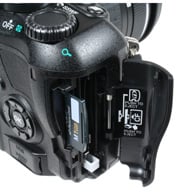 |
The E-410’s powered by the same slim PS-BLS1 1150mAh Lithium Ion battery pack as its predecessor and supplied with a mains recharger. Olympus quotes up to 500 shots, although this will obviously vary depending on how much you use Live View. We managed around 250 shots per charge with the earlier E-400 and impressively around the same with the E-410 even when using Live View from time to time. That said, it was Live View which pushed our battery to extinction on more than one occasion, so it’s best to revert to the optical viewfinder if you’re running low on juice without a spare to hand. Luckily if the E-410 claims the battery is dead following a heavy Live View session, you can normally power it back up again and squeeze a handful of extra shots using the viewfinder before it’s truly spent.
The E-410 can handle both xD and Compact Flash memory cards using two separate slots behind a door on the right side of its body, although sadly you still can’t record to both simultaneously. And finally, behind a small flap on the rear of the E-410 you’ll find a single port delivering both USB and TV connectivity; the E-410’s supplied with two different cables for use with this port.




